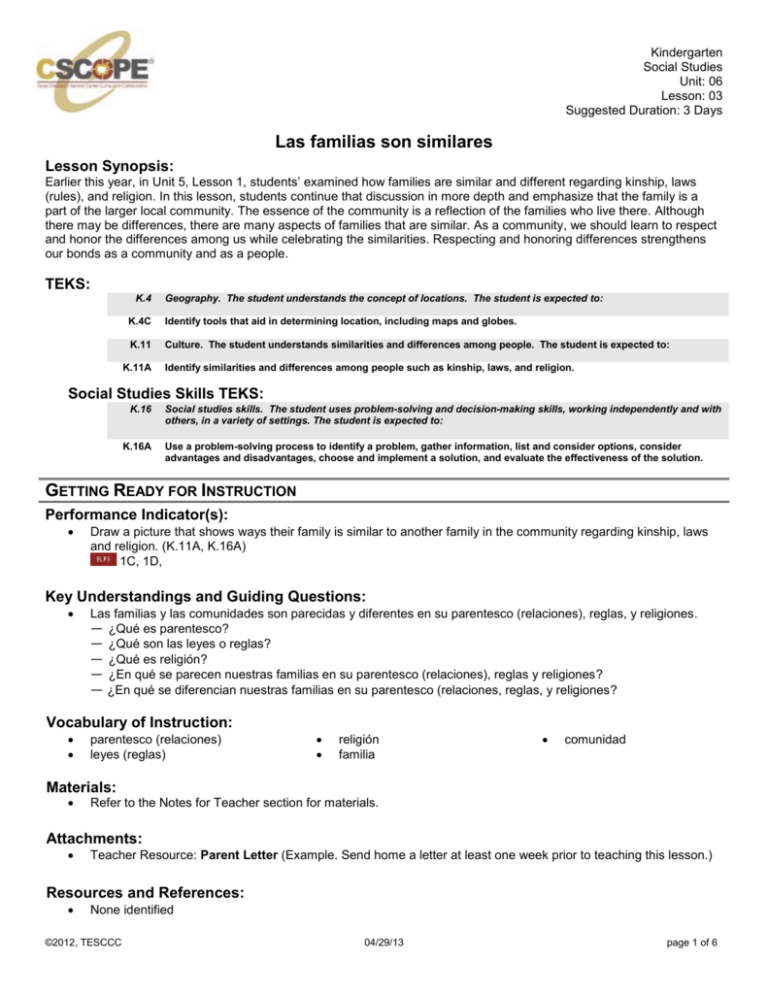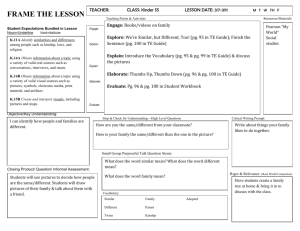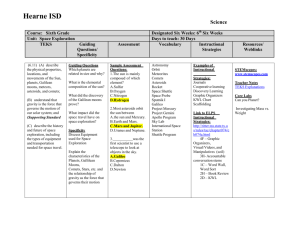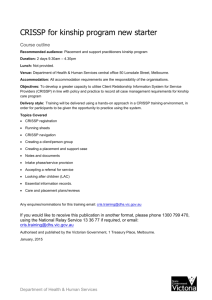Families Are Similar - Midland Independent School District
advertisement

Kindergarten Social Studies Unit: 06 Lesson: 03 Suggested Duration: 3 Days Las familias son similares Lesson Synopsis: Earlier this year, in Unit 5, Lesson 1, students’ examined how families are similar and different regarding kinship, laws (rules), and religion. In this lesson, students continue that discussion in more depth and emphasize that the family is a part of the larger local community. The essence of the community is a reflection of the families who live there. Although there may be differences, there are many aspects of families that are similar. As a community, we should learn to respect and honor the differences among us while celebrating the similarities. Respecting and honoring differences strengthens our bonds as a community and as a people. TEKS: K.4 Geography. The student understands the concept of locations. The student is expected to: K.4C Identify tools that aid in determining location, including maps and globes. K.11 Culture. The student understands similarities and differences among people. The student is expected to: K.11A Identify similarities and differences among people such as kinship, laws, and religion. Social Studies Skills TEKS: K.16 K.16A Social studies skills. The student uses problem-solving and decision-making skills, working independently and with others, in a variety of settings. The student is expected to: Use a problem-solving process to identify a problem, gather information, list and consider options, consider advantages and disadvantages, choose and implement a solution, and evaluate the effectiveness of the solution. GETTING READY FOR INSTRUCTION Performance Indicator(s): Draw a picture that shows ways their family is similar to another family in the community regarding kinship, laws and religion. (K.11A, K.16A) 1C, 1D, Key Understandings and Guiding Questions: Las familias y las comunidades son parecidas y diferentes en su parentesco (relaciones), reglas, y religiones. — ¿Qué es parentesco? — ¿Qué son las leyes o reglas? — ¿Qué es religión? — ¿En qué se parecen nuestras familias en su parentesco (relaciones), reglas y religiones? — ¿En qué se diferencian nuestras familias en su parentesco (relaciones, reglas, y religiones? Vocabulary of Instruction: parentesco (relaciones) leyes (reglas) religión familia comunidad Materials: Refer to the Notes for Teacher section for materials. Attachments: Teacher Resource: Parent Letter (Example. Send home a letter at least one week prior to teaching this lesson.) Resources and References: None identified ©2012, TESCCC 04/29/13 page 1 of 6 Kindergarten Social Studies Unit: 06 Lesson: 03 Advance Preparation: 1. Become familiar with content and procedures for the lesson, especially the idea that families are similar and different regarding kinship, laws (rules), and religion. 2. Refer to the Instructional Focus Document for specific content to include in the lesson. 3. Select appropriate sections of the textbook and other classroom materials that support the learning for this lesson. 4. Preview available resources and websites according to district guidelines. 5. At least one week before teaching this lesson, send home a letter similar to the Teacher Resource: Parent Letter 6. Locate Bubble Chart from Unit 5. 7. Create a family tree to share with students. (If you are not comfortable sharing your own family tree or just prefer not to do so, create one about a fictional family and use it instead. Creating a family tree for a character from children’s literature is another possibility.) 8. Prepare materials and handouts as needed. Background Information: Traditions – passing down customs from generations to generations usually by oral traditions. Kinship – close relationships, usually a blood relationship, but can also include adoption, affinity, or other close association. GETTING READY FOR INSTRUCTION SUPPLEMENTAL PLANNING DOCUMENT Instructors are encouraged to supplement and substitute resources, materials, and activities to differentiate instruction to address the needs of learners. The Exemplar Lessons are one approach to teaching and reaching the Performance Indicators and Specificity in the Instructional Focus Document for this unit. Instructors are encouraged to create original lessons using the Content Creator in the Tools Tab located at the top of the page. All originally authored lessons can be saved in the “My CSCOPE” Tab within the “My Content” area. INSTRUCTIONAL PROCEDURES Instructional Procedures Notes for Teacher ENGAGE – Family tree 1. Read a book about genealogy and family trees. 2. Display a family tree. Read the labels and names. Explain how family members are related and how they connect to one another. NOTE: 1 Day = 30 minutes Suggested Day 1, 10 minutes Materials: books, picture books about families to read aloud reference books family tree Attachments Teacher Resource: Parent Letter (Example. Send home a letter at least one week prior to teaching this lesson.) Purpose: The purpose of this section is to understand how family members are related to one another using a family tree as a visual tool. TEKS: K.11A Instructional Note: Sample family trees are available online and can be found with an internet search for images using the words “family tree”. If you are not comfortable sharing your own family tree or just prefer not to do so, create one about a fictional family and use it instead. Creating a family tree for a character from children’s literature is another possibility. EXPLORE – Families are unique ©2012, TESCCC Suggested Day 1 (continued) – 15 minutes 04/29/13 page 2 of 6 Kindergarten Social Studies Unit: 06 Lesson: 03 Instructional Procedures Notes for Teacher 1. Say: As we continue our study of our neighborhood, we look again at our families. Our families are a part of the larger community, our neighborhood. Because our families are unique, it makes our neighborhood unique. Materials: Returned parent letters 2. Ask: What does “unique” mean? (It means that something or someone is unlike anything or anyone. It is special.) TEKS: K.11A, K.16A 3. Explain that while looking at the family tree, each family is made up of people who are related or kin to one another. Each family has its own family members. Sometimes families have a mother and a father and children. Other times families have only one parent with children, and sometimes they have grandparents who live with grandchildren. (Include the different family situations of children in the class.) Even though they may be different or unique, they are each called a family. Purpose: The purpose of this section is to recognize that each family has a unique history shared by storytelling. Instructional Note: This discussion requires sensitivity to individual children. If you believe a child may not be comfortable with his/her family situation being mentioned, do not force the student to participate publicly. The teacher may choose to visit with the student privately to value their story if the student prefers. 4. Families each have a history, which means they have a past. When we talk about a family’s past we talk about the people who are older than us (like parents, grandparents or great grandparents) or who lived before us. Each of these people has stories about their lives. Families share their history by telling stories about themselves or one another. Stories are usually “handed down” or told from one generation to the next. For example: a grandparent tells a story to a grandchild. 5. Ask: Have your heard stories about your family’s history? Allow time for students to briefly share. 6. Your parents have talked to you about a story in your own family history. We are going to share these stories with the class so we can learn some of the history of all the families in the class. Students can take turns telling the story or standing with the teacher as he/she reads the family history story. EXPLAIN – Turn and talk about family history Suggested Day 1 (continued) – 5 minutes 1. Students turn and talk to a partner. They take turns telling a brief story about one family’s history. (It may or may not be their own family history story.) ENGAGE – Where are families from? 1. Display the map of the world. Ask: What is this? (A picture or chart that represents the world.) Spend a few minutes familiarizing the students with the map. Suggested Day 2, 5 minutes Materials: Map of the world Push pins or thumb tacks Labels to place on the map (each child’s name) Purpose: The purpose of this section is to introduce the world map to students. TEKS: K.4C; K.11A, K.16A ©2012, TESCCC 04/29/13 page 3 of 6 Kindergarten Social Studies Unit: 06 Lesson: 03 Instructional Procedures Notes for Teacher EXPLORE – Families come from many places Suggested Day 2 (continued) – 15 minutes Purpose: The purpose of this section is to locate places that families are from on a worldwide map. Make the connection that our place of origin impacts who we are and can affect our religious beliefs and the rules or laws we follow. 1. Say: Each family represented in our classroom came from somewhere. Many of our families may have lived here in Texas for many, many years. Some of our families may have moved here recently. We are going to look at the places that our families are from. This will help us learn more about our family history. First, let’s find our town or city on the map. (Place a push pin on the location of your town or city on the map with the name on the label.) Next, we will place a label for each of you and your family. 2. Allow students to take turns placing their name label on the appropriate place on the map, using the information from the bottom of the parent letter. 3. When completed, say: We can see where each of our families is from. As we learned in Unit 5, many of our families practice religious beliefs. We worship in a way that our family chooses. Many of our religious beliefs come from our families and this often depends on where our families are from. (See the instructional note.) Other laws that families must follow are city, state and national laws. Unlike religious rules or laws, these laws are enforced by police officers and other authority figures. Most of these laws are the same from one community to another within the state, but there are often some differences. EXPLAIN – Return to Bubble Chart from Unit 5 1. Display Bubble Chart from Unit 5. Read through it as a way to summarize the information on families. Ask students to turn and talk to a partner about the topics covered in this unit that were included on the Bubble Chart: Kinship – how people in families are related to one another. Religion – how religious beliefs affect how we behave toward one another, the clothes we wear, and the food we eat. Rules/laws – how families are governed by the rules and laws of their family and the laws of the city, state and nation. ELABORATE – Bringing it together 1. Facilitate a discussion that helps students conclude that our community takes on the traits or character of the families who live in the community. Refer to the Key Understandings and Guiding Questions: Families and communities are alike and different in their ©2012, TESCCC 04/29/13 TEKS: K.4C; K.11A, K.16A Instructional Note: NOTE: The curriculum in this lesson is based upon the Texas Essential Knowledge and Skills (TEKS), which are the teaching standards required under the provisions of the Texas Education Code. TEKS K11A states that kindergarten students should be able to “Identify similarities and differences among people such as kinship, laws, and religion.” During this activity, students may voice diverse viewpoints regarding the topic of religion. Educators are encouraged to consult with district administration to determine how they should best address these varying perspectives so that all viewpoints are respected and district expectations are met. Suggested Day 2 (continued) – 10 minutes Materials: Bubble Chart from Unit 5 Purpose: The purpose of this section is to refer back to Bubble Chart from Unit 5 and allow students to share in their own words. TEKS: K.11A, K.16A Suggested Day 3 (continued) – 10 minutes Purpose: The purpose of this section is to summarize learning for this lesson. TEKS: K.4C; K.11A, K.16A page 4 of 6 Kindergarten Social Studies Unit: 06 Lesson: 03 Instructional Procedures Notes for Teacher kinship (relationships), rules, and religions. What is kinship? What are rules or laws? What is religion? How are our families alike in their kinship (relationships), rules and religions? How are our families different in their kinship (relationships), rules and religions? 2. Say: Our community or neighborhood is different from any other community or neighborhood because of the families who live here. Think about your own family. 3. Ask: How is your family similar to another family in the neighborhood when it comes to kinship, laws, and religion? EVALUATE – Determine mastery Draw a picture that shows ways their family is similar to another family in the community regarding kinship, laws and religion. (K.11A, K.16A) 1C, 1D Use the problem solving process to complete this Performance Indicator. 1. Identify the problem: Students must find a peer whose family demonstrates something in common. Suggested Day 3 (continued) – 20 minutes Materials: Drawing paper TEKS: K.4C; K.11A, K.16A Instructional Note This is the first time students will be exposed to the problem-solving process. The teacher will directly lead this process and assist students with each step. 2. Gather information: Students will need to talk to other students to understand what they have in common. The teacher will need to lead this discussion to help students begin to find a peer who has similar families. Potential questions are listed below: My family is like ________________’s family because we have grandparents who live in ________. (name another place, such as a country). My family is like ________________’s family because we have _____________ in our families. (a mommy, a daddy and two children, for example). My family is like ________________’s family because we both belong to ________________religion.( name a religion). My family is like ____________’s family because we wear ______________ clothing. (name a type of clothing). My family is like _____________’s family because we don’t eat ____________. (name a food, such as meat) ©2012, TESCCC 04/29/13 page 5 of 6 Kindergarten Social Studies Unit: 06 Lesson: 03 Instructional Procedures Notes for Teacher 3. List and consider options: Students will consider several students’ families as similar to their own. The teacher can help students understand that they have much in common with many families represented in the room 4. Consider advantages/disadvantages: Students will need to consider which family has the most in common with their own family. The teacher will need to direct this process so that each student has a partner. 5. Choose and implement a solution: Students each pick one peer’s family (or the teacher may help the student find a partner) to which they will compare their family by drawing something that they determined was a similarity. 6. Evaluate the effectiveness of the solution: Students will examine each other’s drawings and play a “guessing game” about what the drawing shows the two families have in common. ©2012, TESCCC 04/29/13 page 6 of 6






